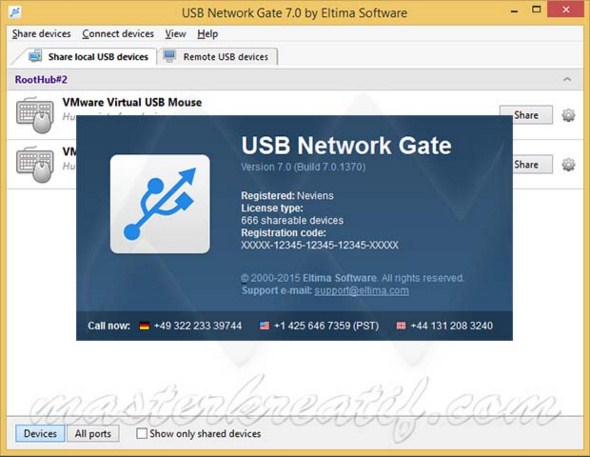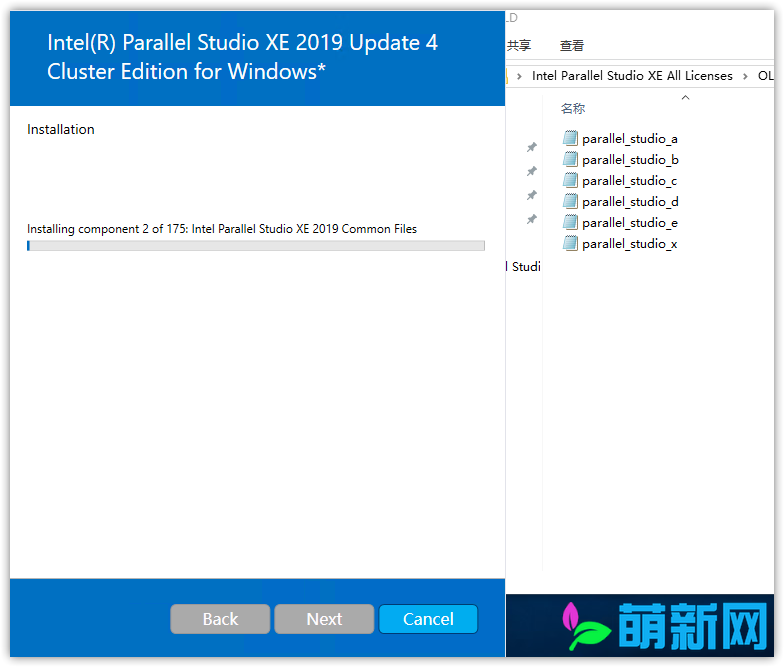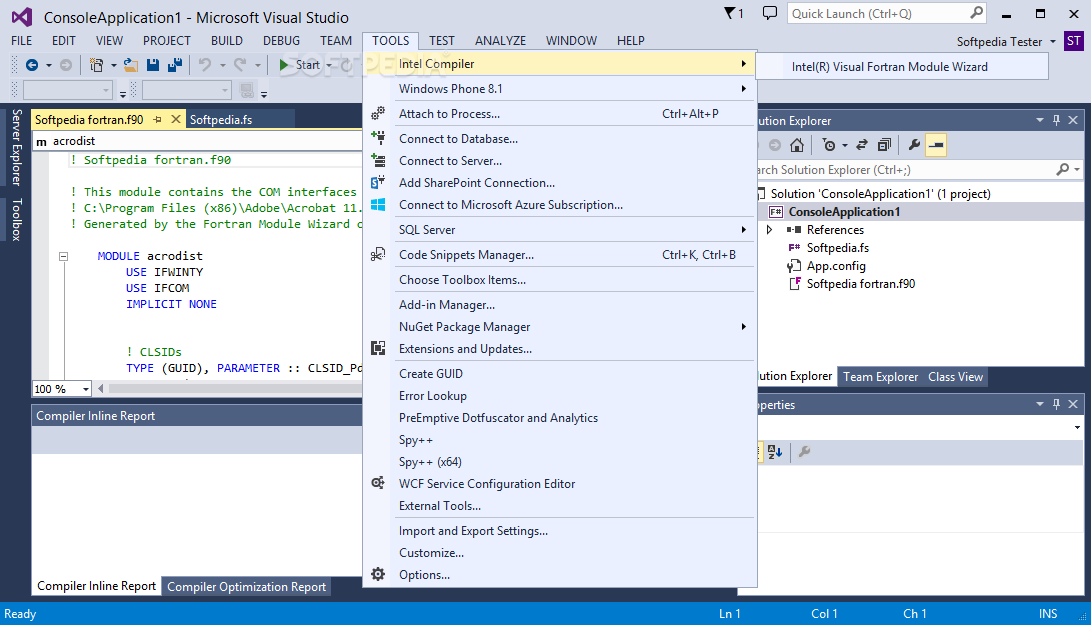- Intel Parallel Studio Xe 2015 Composer Edition For Fortran Iso Machine
- Intel Parallel Studio Xe 2015 Composer Edition For Fortran Iso Mac Os
- Intel Parallel Studio Xe 2015 Composer Edition For Fortran Iso Macro
- Intel Parallel Studio Xe 2015 Composer Edition For Fortran Iso Mac Download
Silent Installation Guide for Intel® Parallel Studio XE Composer Edition for macOS* version 2019
Intel® Parallel Studio XE 2015 Composer Edition for Fortran Linux. includes: Intel® Fortran Compiler; Intel® Math Kernel Library; It allows you to compile Fortran source files on Linux. operating systems for Intel® 64 and IA-32 architectures. You can also use these tools to create applications targeting Intel® Many Integrated Core.
- Intel® Parallel Studio XE 2015 Composer Edition for Fortran OS X. Update 1 includes the following components: Intel® Fortran Compiler XE 15.0.1 for building applications that run on Intel-based Mac.
- Intel Parallel Studio XE 2015 ISO Overview Intel Parallel Studio XE 2015 is a software development application that has been developed by Intel. It will facilitate code development on Windows as well as on Linux in different languages like Fortran and C/C for parallel computing. Intel Parallel Studio is comprised of several components like.
- Intel® Parallel Studio XE 2020 Update 3 is available for the Intel® Parallel Studio XE 2020 Composer Edition for Fortran and C Linux. This is a Linux-only release: there is no Update 3 release for either Windows. or macOS. operating systems.
Silent Installation Guide for Intel® Parallel Studio XE Composer Edition for macOS* version 2018
Silent Installation Guide for Intel® Parallel Studio XE Composer Edition for macOS* version 2016
Here are the steps you can follow to install the Intel® Parallel Studio XE Composer Edition for OS X* version 2016 in silent mode.
Step 0) Start a 'Terminal' program from Utilities group (if you have not done so already) or log into the Mac machine by 'Terminal' windows like PUTTY*, Telnet etc.. Confirm that the userID for the installation has 'sudo' or root privilege. Test your sudo privilege with a simple sudo command such as 'sudo pwd' or 'sudo ls -l'
Step 1) Mount the *.dmg file with required content using 'Finder', for example, by double-clicking on *.dmg. OR If you are working from a terminal window, use the hdiutil command to mount the compiler installer disk image (.dmg)
2016 Example:
Mount the image
sudo hdiutil attach m_fcompxe_2016[_beta].u.vvv.dmg
sudo hdiutil attach m_ccompxe_2016[_beta].u.vvv.dmg
Disk image mounts under
/Volumes/m_fcompxe_2016[_beta].u.vvv (for Intel® Parallel Studio Composer Edition for Fortran OS X*)
/Volumes/m_ccompxe_2016[_beta].u.vvv (for Intel® Parallel Studio Composer Edition for C++ OS X*)
where 'u' is the update number ( 0, 1, 2, 3, etc) and where 'vvv' is the specific version (2016.2.142 is Update 2, version 142 for example), “_beta” suffix is added for Beta packages.
Step 2)Change directory to the “MacOS” folder in 'Terminal':

2016 Example:
cd /Volumes/m_ccompxe_2016_beta.u.vvv/m_ccompxe_2016_beta.u.vvv.app/Contents/MacOS
cd /Volumes/m_fcompxe_2016_beta.u.vvv/m_fcompxe_2016_beta.u.vvv.app/Contents/MacOS
Step 3) In this folder you can find the configuration file silent.cfg, copy it to the location where you have write permissions. This file controls the behavior of the installation. We will explain the configuration file contents below.
Example:
- cp ./silent.cfg /tmp/silent.cfg
Step 4) Edit /tmp/silent.cfg file, at least setting the value of ACCEPT_EULA to “accept”
silent.cfg looks as follows. To proceed with the installation, you should agree with conditions of End User License Agreement (EULA) by setting the value of ACCEPT_EULA to “accept”. By default, the installer looks for license file in “/Users/Shared/Library/Application Support/Intel/Licenses” folder. We recommend you to copy your license file to it before starting the installation. Refer to “Configuration file format” section to find more information about licensing and other customizable options.
# Patterns used to check silent configuration file # # anythingpat - any string # filepat - the file location pattern (/file/location/to/license.lic) # lspat - the license server address pattern (0123@hostname) # snpat - the serial number pattern (ABCD-01234567) # accept EULA, valid values are: {accept, decline} ACCEPT_EULA=decline # optional error behavior, valid values are: {yes, no} CONTINUE_WITH_OPTIONAL_ERROR=yes # install location, valid values are: {/opt/intel, filepat} PSET_INSTALL_DIR=/opt/intel # continue with overwrite of existing installation directory, valid values are: {yes, no} CONTINUE_WITH_INSTALLDIR_OVERWRITE=yes # list of components to install, valid values are: {ALL, DEFAULTS, anythingpat} COMPONENTS=DEFAULTS # installation mode, valid values are: {install, modify, repair, uninstall} PSET_MODE=install # directory for non-RPM database, valid values are: {filepat} #NONRPM_DB_DIR=filepat # Serial number, valid values are: {snpat} #ACTIVATION_SERIAL_NUMBER=snpat # License file or license server, valid values are: {lspat, filepat} #ACTIVATION_LICENSE_FILE= # Activation type, valid values are: {exist_lic, license_server, license_file, trial_lic, serial_number} ACTIVATION_TYPE=exist_lic # Intel(R) Software Improvement Program opt-in, valid values are: {yes, no} PHONEHOME_SEND_USAGE_DATA=no # XCode location, valid values are: {/Applications/XCode.app, filepat} XCODE_DIR=/Applications/XCode.app # integrate the product to XCode, valid values are: {yes, no} XCODE_INTEGRATION_NEEDED=yes |
Step 5) Use 'sudo' to run the silent install (if you are not root user) passing the full path to your configuration file with the --silent option.
Example:
sudo ./install.sh --silent /tmp/silent.cfg
DONE. If your configuration file is accepted the installer will now progress with the installation without further input from you, and no output will appear unless there is an error.
CONFIGURATION FILE FORMAT
A few comments on the directives inside the silent install configuration file:
ACCEPT_EULA=accept |
|
CONTINUE_WITH_OPTIONAL_ERROR |
|
PSET_INSTALL_DIR |
|
CONTINUE_WITH_INSTALLDIR_OVERWRITE |
|
COMPONENTS |
or run trial installation in “duplicate mode” that will create the custom configuration file with the components you select in interactive mode (see details below) |
PSET_MODE |
|
NONRPM_DB_DIR |
|
ACTIVATION_TYPE=exist_lic |
|
ACTIVATION_LICENSE_FILE |
|
ACTIVATION_SERIAL_NUMBER |
|
PHONEHOME_SEND_USAGE_DATA |
|
XCODE_INTEGRATION_NEEDED |
|
XCODE_DIR |
|
Silent Install Steps: 'Copy and Repeat' Method for Silent Configuration File Creation
If you need to make the same sort of installation over and over again, one way to get the silent installation configuration file right the first time is to run the installation program once interactively, using the options that meet the local needs, and record these options into a configuration file that can be used to replicate this same install via silent install for future installations.
To do this, the user simply needs to add the 'duplicate' option to the script invocation, and run a normal interactive install, as follows:
./install.sh --duplicate /tmp/silent.cfg

This '--duplicate' option will put the choices made by you into the file specified on the command line. You can modify this recorded configuration file as appropriate and use it to perform future silent installations.
Silent UnInstall Steps:
Edit /tmp/silent.cfg with PSET_MODE=uninstall
> sudo ./uninstall.sh --silent /tmp/silent.cfg
| Developer(s) | Intel |
|---|---|
| Stable release | |
| Operating system | Linux, Windows, OS X |
| Type | Compiler |
| License | Freeware, Optional priority support |
| Website | software.intel.com/content/www/us/en/develop/tools/oneapi/components/fortran-compiler.html |
| Developer(s) | Intel |
|---|---|
| Preview release | 2021.1.2[2] / December 20, 2020; 36 days ago |
| Operating system | Linux, Windows |
| Type | Compiler |
| License | Freeware, Optional priority support |
| Website | software.intel.com/content/www/us/en/develop/tools/oneapi/components/fortran-compiler.html |
Intel Fortran Compiler, is a group of Fortrancompilers from Intel for Windows, OS X, and Linux.
Overview[edit]
The compilers generate code for IA-32 and Intel 64 processors and certain non-Intel but compatible processors, such as certain AMD processors. A specific release of the compiler (11.1) remains available for development of Linux-based applications for IA-64 (Itanium 2) processors. On Windows, it is known as Intel Visual Fortran.[3] On OS X and Linux, it is known as Intel Fortran. In 2020 the existing compiler was renamed “Intel Fortran Classic” (ifort) and a new Intel Fortran Compiler (beta) (ifx) supporting GPU offload was introduced.
Intel Parallel Studio Xe 2015 Composer Edition For Fortran Iso Machine

The 2021 release of the Classic compiler adds full Fortran support through the 2018 standard, full OpenMP* 4.5, and Initial Open MP 5.1 for CPU only. The 2021 beta compiler focuses on OpenMP for GPU Offload. When used with the Intel HPC toolkit (see the 'Description of Packaging' below) the compiler can also automatically generate Message Passing Interface calls for distributed memory multiprocessing from OpenMP directives.
For more information on Fortran standards, a number or resources are available, such as the Wikipedia Fortran entry or the Fortran wiki page. When used with Intel cluster tools (see the 'Description of Packaging' below) the compiler can also automatically generate Message Passing Interface calls for distributed memory multiprocessing from OpenMP directives.
Intel Parallel Studio Xe 2015 Composer Edition For Fortran Iso Mac Os
Optimizations[edit]
Intel compilers are optimized[4] for computer systems using processors that support Intel architectures. They are designed to minimize stalls and to produce code that executes in the fewest possible number of cycles. Intel Fortran Compilers support three separate high-level techniques for optimizing the compiled program: interprocedural optimization (IPO), profile-guided optimization (PGO), and other high-level optimizations (HLO).
Interprocedural optimization applies typical compiler optimizations (such as constant propagation) but uses a broader scope that may include multiple procedures, multiple files, or the entire program.[5]
Regarding profile-guided optimization, the compiler generates a dataset of performance-related information from using the application with representative workloads, which it then analyzes to find which parts of the application are executed more and less frequently. The compiler uses these data to organize application execution to optimize performance based on how the application is actually used. This is in contrast to IPO which optimizes applications according to the logical flow of the application independent of workloads. The two can be combined to provide workload-based optimizations within which the logical-flow is optimized. Thus, all optimizations can benefit from profile-guided feedback because they are less reliant on heuristics when making compilation decisions.
High-level optimizations are optimizations performed on a version of the program that more closely represents the source code. This includes loop interchange, loop fusion, loop unrolling, loop distribution, data prefetch, and more.[6]
Standards support[edit]
The Intel Fortran Compiler Classic fully supports Fortran through the 2018 standard. The Intel Fortran Compiler (Beta) supports full Fortran 77/90/95 and has partial support of the Fortran 2003 standard.
Architectures[edit]

- x86-64 (Intel 64 and AMD64)
- IA-64 (Itanium 2)
Description of packaging[edit]
/https%3A%2F%2Fi.ytimg.com%2Fvi%2F0jtzhvq7Rpg%2Fhqdefault.jpg)
The compilers are available standalone from Intel and from APT and Yum repositories. They are also available in the Intel oneAPI HPC Toolkit which includes other build tools, such as libraries, and analysis tools for error checking and performance analysis. Containers with the compilers are on Docker Hub.
History since 2003[edit]
Intel Parallel Studio Xe 2015 Composer Edition For Fortran Iso Macro
| Compiler version | Release date | Major new features |
|---|---|---|
| Intel Fortran Compiler 8.0 | December 15, 2003 | Precompiled headers, code-coverage tools. |
| Intel Fortran Compiler 8.1 | September, 2004 | AMD64 architecture (for Linux). |
| Intel Fortran Compiler 9.0 | June 14, 2005 | AMD64 architecture (for Windows), software-based speculative pre-computation (SSP) optimization, improved loop optimization reports. |
| Intel Fortran Compiler 10.0 | June 5, 2007 | Improved parallelizer and vectorizer, Streaming SIMD Extensions 4 (SSE4), new and enhanced optimization reports for advanced loop transformations, new optimized exception handling implementation. |
| Intel Fortran Compiler 10.1 | November 7, 2007 | New OpenMP* compatibility runtime library. To use the new libraries, you need to use the new option '-Qopenmp /Qopenmp-lib:compat' on Windows, and '-openmp -openmp-lib:compat' on Linux. This version of the Intel compiler supports more intrinsics from Microsoft Visual Studio 2005. VS2008 support - command line only in this release. |
| Intel Fortran Compiler 11.0 | November 2008 | More Fortran 2003 support. Support for OpenMP 3.0. Source Checker for static memory/parallel diagnostics. Commercial licenses for Windows version include Microsoft Visual Studio 2005 Premier Partner Edition. |
| Intel Fortran Compiler 11.1 | June 23, 2009 | Support for latest Intel SSE, AVX and AES instructions. More Fortran 2003 support. Support for latest Intel MKL release (included in compiler products). Commercial licenses for Windows version include Microsoft Visual Studio 2008 Shell and libraries. |
| Intel Fortran Composer XE 2011 up to Update 5 (compiler 12.0) | November 7, 2010 | Coarray Fortran, additional 2003 (FINAL subroutines, GENERIC keyword,) and 2008 (Coarrays, CODIMENSION, SYNC ALL, SYNC IMAGES, SYNC MEMORY, CRITICAL, LOCK, ERROR STOP, ALLOCATE/DEALLOCATE) |
| Intel Fortran Composer XE 2011 Update 6 and above (compiler 12.1) | September 8, 2011 | OpenMP 3.1, additional 2003 (ALLOCATE with SOURCE=, polymorphic source) and 2008 standards support, Windows version ships with Visual Studio 2010 Shell. |
| Intel Fortran Composer XE 2013 (compiler 13.0) | September 5, 2012 | Linux-based support for Intel Xeon Phi coprocessors, support for Microsoft Visual Studio 12 (Desktop), support for gcc 4.7, support for Intel AVX 2 instructions, updates to existing functionality focused on delivering improved application performance. Continued availability of the Visual Studio 2010 Shell for Windows versions. |
| Intel Fortran Composer XE 2013 SP1 (compiler 14.0) | July 31, 2013 | User-Defined Derived Type I/O; OpenMP directives, clauses and procedures; coarrays ; Microsoft Visual Studio parallel build support |
| Intel Fortran Composer XE 2013 SP1 Update 1 (compiler 14.0.1) | October 18, 2013 | Japanese localization of 14.0; Windows 8.1 and Xcode 5.0 support |
| Intel Fortran Composer XE 2015 (compiler 15.0) | August 5, 2014 | Full support for Fortran 2003; BLOCK from Fortran 2008; EXECUTE_COMMAND_LINE from Fortran 2008; New optimization report annotates the source from within Visual Studio[7] |
| Intel Fortran Composer XE 2015 Update 1 (compiler 15.0.1) | October 30, 2014 | AVX-512 support; Japanese localization; MIN/MAX Reductions in SIMD Loop Directive |
| Intel Fortran Compiler 16.0, part of Intel Parallel Studio XE 2016 | August 25, 2015 | Submodules from Fortran 2008, enhanced interoperability of Fortran with C from draft Fortran 2018, OpenMP 4.1 extensions |
| Intel Fortran Compiler 17.0 | March 4, 2016 | OpenMP 4.5 extensions |
| Intel Fortran Compiler 18.0 | January 17, 2017 | Full Fortran 2008 support |
| Intel Fortran Compiler 19.0 | September 12, 2018 | Some Fortran 2018 features |
| Intel Fortran Compiler Classic 2021.1.1 | December 8, 2020 | Full Fortran 2018 support, OpenMP 4.5 and initial Open MP 5.1 for CPU only |
| Intel Fortran Compiler (Beta) 2021.1.1 | December 8, 2020 | OpenMP* 4.5 and initial OpenMP support for CPU and GPU Offload |
Debugging[edit]
The Intel compiler provides debugging information that is standard for the common debuggers (DWARF 2 on Linux, similar to gdb, and COFF for Windows). The flags to compile with debugging information are /Zi on Windows and -g on Linux. Debugging is done on Windows using the Visual Studio debugger, and on Linux using gdb.
While the Intel compiler can generate a gprof-compatible profiling output, Intel also provides a kernel-level, system-wide statistical profiler as a separate product called VTune. VTune features an easy-to-use GUI (integrated into Visual Studio for Windows, Eclipse for Linux) as well as a command-line interface. In addition to the VTune profiler, there is Intel Advisor that specializes in vectorization optimization and tools for threading design and prototyping.
Intel also offers a tool for memory and threading error detection called Intel Inspector XE. Regarding memory errors, it helps detect memory leaks, memory corruption, allocation/de-allocation of API mismatches and inconsistent memory API usage. Regarding threading errors, it helps detect data races (both heap and stack), deadlocks and thread and synch API errors.
See also[edit]
- Intel Integrated Performance Primitives (IPP)
- Intel Data Analytics Acceleration Library (DAAL)
- Intel Math Kernel Library (MKL)
- Intel Threading Building Blocks (TBB)
- VTune Amplifier
- Intel Developer Zone (Intel DZ; support and discussion)
Intel Parallel Studio Xe 2015 Composer Edition For Fortran Iso Mac Download
References[edit]
- ^'Intel® Fortran Compiler for oneAPI Release Notes'. Intel. Retrieved 2020-12-28.
- ^'Intel® Fortran Compiler for oneAPI Release Notes'. Intel. Retrieved 2020-12-28.
- ^'Intel Visual Fortran Compiler Professional Edition for Windows'. cnet.com.
- ^'Intel (Fortran, C, and C++)'. NERSC.gov.
- ^Intel compiler documentation. Select the Fortran compiler of choice and search for Profile-Guided Optimization. http://software.intel.com/en-us/intel-software-technical-documentation
- ^The Software Optimization Cookbook, High-Performance Recipes for IA-32 Platforms, Richard Gerber, Aart J.C. Bik, Kevin B. Smith, and Xinmin Tian, Intel Press, 2006
- ^'Intel Visual Fortran 15 now available'.
External links[edit]
- Official website
